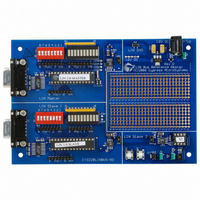CY3220LINBUS-RD Cypress Semiconductor Corp, CY3220LINBUS-RD Datasheet - Page 21

CY3220LINBUS-RD
Manufacturer Part Number
CY3220LINBUS-RD
Description
KIT REF DESIGN LIN BUS
Manufacturer
Cypress Semiconductor Corp
Series
PSoC®r
Datasheet
1.CY3220LINBUS-RD.pdf
(64 pages)
Specifications of CY3220LINBUS-RD
Main Purpose
Interface, LIN
Embedded
Yes, MCU, 8-Bit
Utilized Ic / Part
CY8C27143, CY8C27443
Processor To Be Evaluated
CY8C27143-24PXI and CY8C27443-24PXI
Interface Type
RS-232
Lead Free Status / RoHS Status
Contains lead / RoHS non-compliant
Lead Free Status / RoHS Status
Lead free / RoHS Compliant, Contains lead / RoHS non-compliant
Other names
428-1926
LIN Bus 2.0 Reference Design
7. The “Resolve name conflicts” window lists functions in
8. Below this, details of the design such as date of creation,
9. Click OK.
10. Now in the Device Selection window, select the device
11. Select “Generate main file using C.”
12. Select “Device Editor” as the Designer State.
13. Click Finish.
14. A Design Import Status window opens and displays the
15. When the design is imported, PSoC Designer opens the
16. Four configurations are visible. The base configuration
17. Go to Project >> Settings, Device Editor tab. In the con-
18. Now switch to the base configuration and select all the
3.6.2
Now switch to the Interconnect View and select the base
configuration. First, configure all the global resources
related to the LIN design. Whatever changes made to the
base configuration, are reflected in the other three loadable
configurations.
1. Set CPU speed to 24 MHz. (Set the CPU speed to 12
2. Set 32 kHz to External.
3. Set the PLL to Enabled.
4. Set VC1 divider to 12.
These are the required global resources for the LIN master.
The clock VC1 is used as the source clock to LIN modules.
The divider is set to 12 in the firmware so that the output of
VC1 is 2 MHz. Take this into account when using VC1 and
VC2 in the main application. You can set all the other global
resources in your main application.
3.6.3
Next, decide the TX and RX pins of the LIN bus. To properly
select their drive modes in all configurations, follow these
steps carefully.
1. Switch to the base configuration. Use the Config >>
2. Return to the base configuration.
3. In the GPIO configuration pane, rename the port pin you
October 25, 2006
the imported design that have the same name as func-
tions in the existing project. When there is a name con-
flict, clicking the “Auto Resolve” button automatically
renames the conflicting function names.
description and the base part number are displayed.
for the project.
import status.
Device Editor.
with the project name, the Synchro Break Configuration,
Data Transmission Configuration and the Data Recep-
tion Configuration.
figuration initialization type, select “Direct Write (Speed
Efficient).”
user modules to include in the main application.
MHz for the CY8C27x43 automotive grade device.)
Restore default pinout. All the pins in the GPIO configu-
ration pane become StdCPU, High Z Analog, DisableInt.
Repeat this step for the synchro break, data transmis-
sion and data reception configurations.
plan to use as the RX pin to “RX.” Then rename the pin
Configuring Global Resources
Configuring GPIO
Cypress Semiconductor – Rev. **
4. In the Select column of the RX pin, select the
5. In the Select column of the TX pin, select the
6. Switch to synchro break, data transmission and data
The GPIO configuration is done. After this, modify the GPIO
of the other port pins according to the main project require-
ments. Whenever a modification is done in the base configu-
ration, the same settings are updated in the other three
configurations. Thus, regardless of which configuration is
active, the GPIO state of the main application is maintained.
When the process is complete, the configuration of the TX
and RX pins looks like this:
Table 3-1. TX Pin
Table 3-2. RX Pin
3.6.4
The next step is to route the signals to the digital blocks of
the LIN configurations.
1. Go to the Synchro Break Configuration.
2. Route the Compare Out of the synchro break counter to
3. From this Row_1_Output_x net, route the signal to the
4. Switch to the Data Transmission Configuration.
5. Route the output of the TX8 to the same
6. Switch to the Data Reception Configuration.
7. Route the Global_Input net to which RX is connected, to
Base
Synchro Break
Data Transmission TX
Data Reception
Base
Synchro Break
Data Transmission RX
Data Reception
Configuration
Configuration
you plan to use as the TX pin as “TX.” Capitalize these
letters.
GlobalInOdd_x or GlobalInEven_x. The drive mode
automatically becomes High Z.
GlobalOutOdd_x or GlobalOutEven_x. The drive mode
automatically becomes Strong.
reception configurations and check that these changes
are reflected.
the appropriate Row_1_Output_x line. For example, if
you have configured P0[3] as TX pin, then route the
Compare out to Row_1_Output_3 net.
appropriate GlobalOut bus to which the TX pin is con-
nected.
Row_1_Output_x line used by the synchro break
counter (step 2) and from there to the GlobalOut bus to
which TX pin is connected.
an appropriate Row_1_Input_x net. Select Synch to
SysClk in the Synchronization box. For example, if P0[2]
is used as RX, then connect GlobalIn_Even_2 bus to
Row_1_Input_2 net.
Routing the Signals
RX
RX
RX
TX
TX
TX
Name
Name
As selected
As selected
As selected
As selected
As selected
As selected
As selected
As selected
Port
Port
GlobalOut Strong DisableInt
GlobalOut Strong DisableInt
GlobalOut Strong DisableInt
GlobalOut Strong DisableInt
GlobalIn
GlobalIn
GlobalIn
GlobalIn
Select
Select
3. Master Design IP
High Z
High Z
High Z
High Z
Drive
Drive
Interrupt
DisableInt
DisableInt
DisableInt
DisableInt
Interrupt
19












